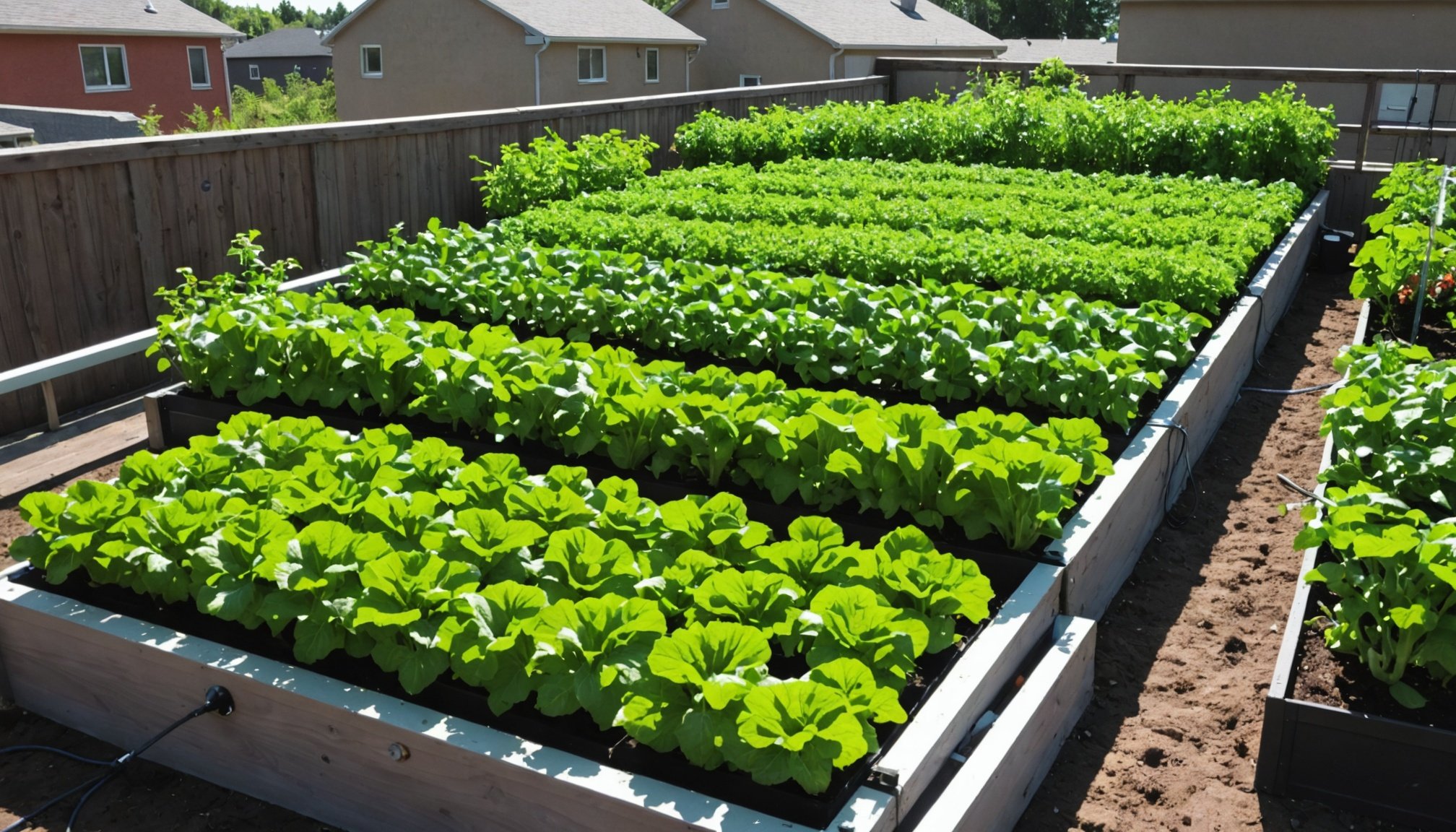Mastering Rooftop Gardening: Create a High-Performance Irrigation System for Your Vegetable Paradise
Why Rooftop Gardening is a Game-Changer
Rooftop gardening has become increasingly popular as people seek to transform unused urban spaces into vibrant garden oases. This method of gardening not only provides a peaceful retreat but also offers a sustainable way to grow your own vegetables and herbs, even in the heart of the city. However, one of the key challenges in rooftop gardening is managing water efficiently. Here’s how you can create a high-performance irrigation system to ensure your garden thrives.
Understanding Your Garden’s Water Needs
Before you start designing your irrigation system, it’s crucial to understand the specific water needs of your plants. Different plants have varying moisture requirements, and this can change with the seasons.
Also to see : Creating a Stunning and Practical Water Recycling Feature for Your Garden: A Complete Guide
Assessing Soil Moisture
To determine when your plants need watering, you can use a soil moisture meter. This tool is simple and handy for checking the moisture levels in your soil. Here’s how to use it effectively:
- Clean the probe and switch to the moisture position.
- Insert the probe into the soil about 2-4 inches deep.
- Check the moisture level on the dial immediately.
- Remove the probe and wipe it clean after each use.
Designing an Eco-Friendly Irrigation System
An eco-friendly irrigation system is essential for sustainable gardening. Here are some key components and practices to consider:
In the same genre : Creating the Perfect Adjustable Lighting System for Your Home Art Studio: A Step-by-Step Guide
Water Conservation
One of the most significant benefits of a well-designed irrigation system is water conservation. Here are a few strategies to reduce water usage:
- Rainwater Harvesting: Installing rain barrels to collect and store rainwater for irrigation reduces your dependence on municipal water supplies. This is particularly effective in areas with frequent rainfall.
- Drip Irrigation: Drip irrigation systems deliver water directly to the roots of the plants, reducing evaporation and runoff. This method is highly efficient and can save a significant amount of water.
- Mulching: Mulch helps retain soil moisture, reducing the need for frequent watering.
Using Sustainable Materials
When building your irrigation system, consider using sustainable materials:
- Recycled Materials: Use recycled plastic or metal for your irrigation pipes and fittings.
- Solar-Powered Pumps: If you’re using a pump to distribute water, consider a solar-powered option to reduce your reliance on traditional energy sources.
Components of a High-Performance Irrigation System
A high-performance irrigation system involves several key components that work together to ensure your garden receives the right amount of water at the right time.
Irrigation Controllers
An irrigation controller is the brain of your irrigation system. It allows you to schedule watering sessions and adjust them based on weather conditions.
Drip Irrigation Tubing
Drip irrigation tubing is designed to deliver water directly to the roots of your plants. Here are some tips for using it effectively:
- Place tubing near plant roots: Ensure the tubing is positioned close to the roots of your plants to maximize water absorption.
- Use filters: Install filters to prevent clogging of the tubing.
- Check for leaks: Regularly inspect the tubing for any leaks or damage.
Watering Globes
For smaller gardens or specific plants, watering globes can be a useful addition. Here’s how they work:
- Constant Moisture: Watering globes administer a steady dose of water as the soil dries out, preventing overwatering and ensuring consistent moisture levels.
- Proper Placement: Position the globe at a slight angle and away from direct sunlight to prevent algae growth.
Tips for Effective Irrigation
Here are some practical tips to ensure your irrigation system operates efficiently:
Monitor Water Levels
Regularly check the water levels in your irrigation system. For example, if you’re using watering globes, refill them when they are nearly empty and adjust the frequency based on the season.
Adjust for Seasonal Changes
Plants have different water needs during different seasons. Here’s a breakdown:
| Season | Watering Needs |
|---|---|
| Spring | Plants require more water as they start growing and producing new leaves. |
| Summer | High temperatures mean plants need more frequent watering. |
| Fall | As temperatures cool, plants require less water. |
| Winter | Most plants are dormant and require minimal watering. |
Use Organic and Natural Methods
Incorporate organic and natural methods into your gardening practices to maintain soil health and reduce the need for chemical pesticides and fertilizers.
- Composting: Set up a compost system to recycle kitchen scraps and garden waste into nutrient-rich soil.
- Beneficial Insects: Introduce beneficial insects like ladybugs or use natural pest deterrents like neem oil for pest control.
Maintaining Your Garden Oasis
Maintaining your rooftop garden involves more than just watering. Here are some additional tips to keep your garden thriving:
Garden Beds and Soil Health
- Raised Beds: Use raised beds to improve soil drainage and aeration. This is especially important in rooftop gardens where soil compaction can be a issue.
- Soil Health: Regularly test your soil pH and adjust it if necessary. Use organic soil amendments to maintain soil health.
Water Features
- Ponds and Fountains: Incorporate water features like ponds or fountains to add aesthetic value and create a peaceful environment. These can also help in cooling the surrounding area through evaporation.
Real-Life Examples and Success Stories
Many gardeners have successfully implemented high-performance irrigation systems in their rooftop gardens. Here’s an example:
Jeremy Ford, a farmer in Florida, installed an automated underground irrigation system powered by a solar pump. This system has saved him thousands of gallons of water and reduced his labor costs significantly. “It’s much more efficient,” Ford said. “We’ve tried to figure out ‘How do we do it?’ with the least amount of adding labor”.
Creating a high-performance irrigation system for your rooftop garden is a rewarding and sustainable way to ensure your plants thrive. By understanding your garden’s water needs, designing an eco-friendly system, and maintaining your garden with organic and natural methods, you can enjoy a lush and productive garden oasis even in the midst of a bustling city.
Practical Insights and Actionable Advice
Here are some final tips to help you get started:
- Start Small: Begin with a small section of your garden and expand as you gain experience.
- Monitor and Adjust: Regularly monitor your plants and adjust your irrigation system accordingly.
- Seek Advice: Consult with local gardening experts or join a gardening community to learn from others.
By following these guidelines and tips, you can master rooftop gardening and enjoy the fruits of your labor in a sustainable and eco-friendly way.
Detailed Bullet Point List: Key Components of a High-Performance Irrigation System
-
Irrigation Controllers:
-
Schedule watering sessions
-
Adjust based on weather conditions
-
Automate watering to save time and water
-
Drip Irrigation Tubing:
-
Deliver water directly to plant roots
-
Use filters to prevent clogging
-
Regularly inspect for leaks or damage
-
Watering Globes:
-
Administer steady dose of water as soil dries out
-
Position at a slight angle and away from direct sunlight
-
Refill when nearly empty and adjust frequency based on season
-
Rainwater Harvesting:
-
Collect and store rainwater in barrels
-
Reduce dependence on municipal water supplies
-
Use for irrigation to conserve water
-
Solar-Powered Pumps:
-
Reduce reliance on traditional energy sources
-
Efficient and eco-friendly
-
Ideal for rooftop gardens with limited access to electricity
-
Mulching:
-
Retain soil moisture
-
Reduce need for frequent watering
-
Use organic mulch to maintain soil health
Comprehensive Table: Seasonal Watering Needs
| Season | Watering Needs | Tips |
|---|---|---|
| Spring | Plants require more water as they start growing and producing new leaves. | Start watering earlier in the spring to support new growth. |
| Summer | High temperatures mean plants need more frequent watering. | Increase watering frequency, especially during heatwaves. |
| Fall | As temperatures cool, plants require less water. | Gradually reduce watering as the weather cools down. |
| Winter | Most plants are dormant and require minimal watering. | Water sparingly, focusing on maintaining soil moisture rather than saturation. |
Relevant Quotes
- “It’s much more efficient. We’ve tried to figure out ‘How do we do it?’ with the least amount of adding labor,” – Jeremy Ford, farmer in Florida.
- “A lot of farmers are struggling with labor. [Automation] is a solution to the nation’s agricultural workforce shortage,” – Will Brigham, dairy and maple farmer in Vermont.
- “We can account for climate change by timing pollen perfectly as it’s delivered. And it takes a lot of that labor that’s hard to come by out of the equation,” – Jason Cope, co-founder of PowerPollen.











